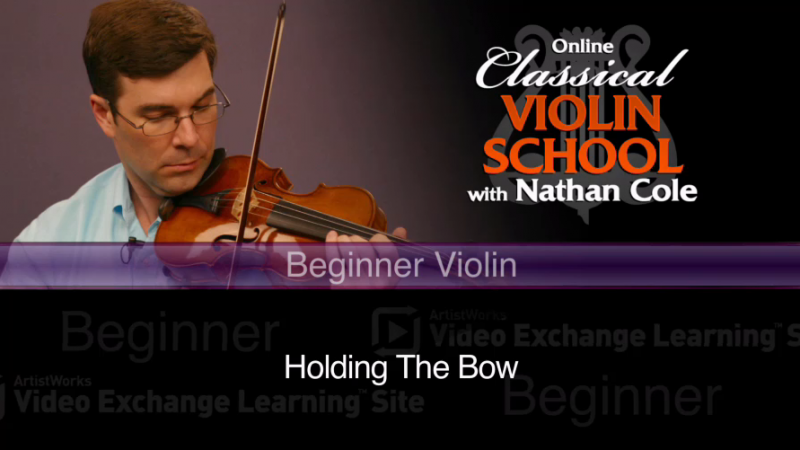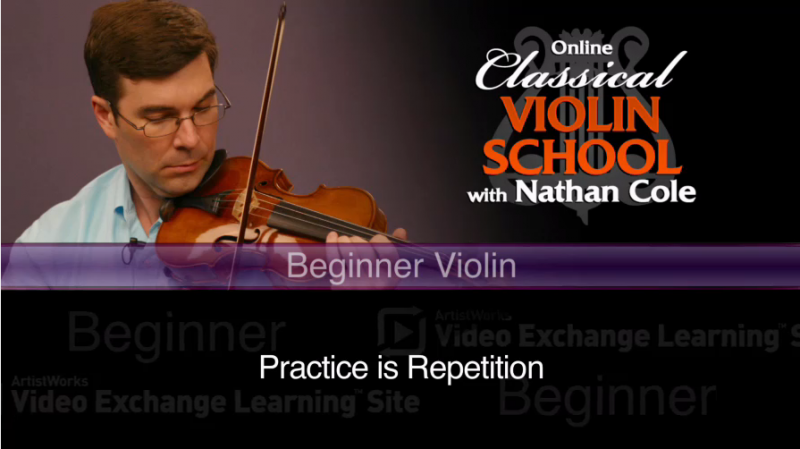New Beginner Violin Lessons from Nathan Cole

ArtistWorks is proud to announce that we have re-launched Nathan Cole's Online Classical Violin School with a focus on beginner violin lessons. Now everyone including beginners can learn how to play violin with a first chair violinist from the LA Philharmonic. Nathan's beginner-friendly approach embraces the idea that learning how to play violin should be fun and rewarding at every level - regardless of technical ability.
There's over 60 new lessons added to Nathan Cole's core curriculum, including many new fundamental violin basics and beginner violin songs. You don't need to know how to read music in order to follow along, Nathan's online lessons contain everything you need to learn how to play violin - and you can do it all on your own time, at your own pace.
New Beginner Violin Lessons:
- Adult Beginner Coaching
- Tuning the Violin
- Holding the Bow
- Sound Production
- Detaché
- Basic Hand Shape
- Martelé
- Basic Shifting
- Bow Changes
- Basic Vibrato
- Collé
- Basic Spiccato
- String Crossings
- Audition Prepararion
- Audition Timetable
New Beginner Violin Songs:
- "B-I-N-G-O"
- "Danny Boy"
- "Baa Baa Black Sheep"
- "Pop Goes the Weasel"
- "Hail to the Chief"
- "Jingle Bells"
- "O Come All Ye Faithful"
- "This Old Man"
- "Battle Hymn of the Republic"
- "America the Beautiful"
- "Pomp and Circumstance"
- "Star Spangled Banner"
- "Colonel Bogey March"
- "Irish Washer Woman"
- "Deck The Halls"
- "Turkey in the Straw"
- "Washington Post March"
Plus many more Intermediate and Advanced Violin Lessons added, see the full list here!

We asked Nathan recently his thoughts about playing music and his philosopohy on learning how to play violin:
"The great thing about playing music is that you can enjoy every step along the way. You have easier songs; you have more difficult songs, but the reward is there when you play a song for someone and they never knew you played an instrument. Or, you have a friend who plays piano or guitar and suddenly you can play something together - whether you're reading from (sheet) music or not. And that's a wonderful moment that you can look forward to no matter when you're starting.” - Nathan Cole
So what do you do when it gets boring practicing violin?
"Well, entire books could be (and have been) written on practice methods, and that’s because no one method can solve every problem. I really believe in a 'kitchen sink' approach, where you work a problem from every conceivable angle. So I totally agree that practicing the same thing over and over again is boring!
"That said, the overall strategy for improving a passage is consistent: hear what is; decide on a change; play the change; hear again what is. That means that in an ideal world, your ear is telling you exactly how something would sound to an outside listener; you know what you would like to change; you make the change using various practice tactics; you play it many times, hearing the change you’ve made.
"What happens for most people is that their ear gives them some combination of their true sound and what they wish they sounded like. They don’t have a clear idea of what they want to change, so they try the passage over and over. They try the same practice tactics they’ve always relied on; and they try to play the passage again and get frustrated that they haven’t made progress. That’s because there was a lot of trying and no strategy!
"So the first step is to hone your ear. Recording is key, because as the saying goes, 'the microphone doesn’t lie'! Actually, mics can be misleading, but the brain is usually much more so. Choose something very basic to listen for, such as intonation in a simple scale, or the smooth connection between bow strokes. The key is to listen while you play, and then to compare that impression with your impression as you listen to playback. Were the impressions exactly the same? Congratulations, you have a perfect ear! Most people need some work in this area, however, and the truth is that everyone, even the pros, must constantly hone their ears through these kinds of listening exercises.
"Next, you have to decide exactly what you want to change. Not how you’re going to make that change, but simply what you want to be different. Many people skip this step, so it’s no wonder that they don’t end up with any result! Maybe it’s a note that you’d like higher, or a crescendo instead of a diminuendo. The key is to pick just one thing to change, rather than a blanket 'I want this to be fast, in tune, and interesting!'
"Then play the change. Often that’s all there is to it! Most of us don’t need a coach to tell us how to put a finger higher, or how to make a crescendo. So play the change, and play it many times, not worrying about other changes you’d like to make just yet.
"Finally, play the passage again and see if you’ve made the change the way you imagined. Again, you’re using your well-honed ear to give you true feedback about what’s coming out of your violin.
"Does it sound like I’ve skipped the part about how to practice? Actually, this is the way I practice. This is the strategy. The smaller pieces, the tactics, number in the thousands. They include all the things you mentioned, plus so many more. That’s where a teacher comes in most handy, because different tactics work better for different problems. But the strategy? That’s up to you to follow consistently for every problem you face."

Which methods do you find to be more effective?
"Some of the tried-and-true practice tactics are: playing even rhythms deliberately unevenly (dotted rhythms) in order to make them steadier; playing a fast passage slowly, but with the same sound, intensity and direction as before; playing a slow passage faster, to make it easier to show overall direction; playing short (3 or 4 note) groups in tempo, then stitching them together."
What is a commonly used method you observe in students that is ineffective?
"The winner (or loser!) would have to be taking a fast passage, automatically putting the metronome on a slow tempo, and playing the passage with the metronome. If you’re doing this for a specific reason, it can work well enough, but it’s rarely the best tactic and can actually be counterproductive. That’s because there’s no awareness of why you’re slowing down in the first place. Is it because something was out of tune? Uneven? Bad sound? Tension? This goes back to strategy. What is it that your’e hearing, and what do you wish would change? You may not need to change the tempo in order to accomplish your goal! It’s true that slowing a passage down makes it easier in almost every case, but without having some idea of what you’re trying to change, you will find it difficult to show improvement in the performance tempo."
What do you do when you get stuck no matter how many times you practice?
"Either take a break, go to a different passage or piece, or 'change the rules'. But by no means continue something that feels like failing. By 'change the rules' I mean begin succeeding. If you’d like to perform a fast passage at quarter=120, but it’s uneven and out of tune every time you play at that tempo, then quit playing at that tempo! Focus first on pitch, and play groups of just a few notes in tune. Now you’re succeeding. You’ll get to quarter=120, but with small steps. Now turn to even-ness. Is this the kind of passage that trips you up consistently? Maybe it’s time to take a detour toward an etude that works that skill and only that skill. You can succeed with that and come back to the 'problem' passage later."
Many musicians are multi-talented people, so how do you efficiently spend your practicing time?
"Mostly by mixing things up and maintaining an awareness of what I’m trying to accomplish. I think it’s important to do some fundamental work each day. The traditional ratio for developing virtuosi who practice 4 or 5 hours a day is something along the lines of 20% scales, 20% etudes and 60% repertoire. That’s a lot of scales and etudes! But you can use a similar idea no matter how much you’re practicing. There’s a limit, of course. If you’ve only got 30 minutes a day, those 5 minutes of scales every day aren’t going to do a whole lot for you. You can focus on a scale or etude one day and play through a couple of pieces at the end, then the next day work mostly on your pieces with a bit of scale work. But the mix is important.
"No matter how much time you spend, the key is focused listening combined with an awareness of what you’d like to change. That can be difficult to know for an inexperienced player, which is why a teacher is so important. With that knowledge, you can spend your time making changes that will get immediate results, as well as strengthening your playing for the future."
What do you do when you have a lot of music to learn but not enough time?
"That’s a stressful situation to be in! The first step is not to get into it… to plan ahead and get music well in advance. But let’s say it’s too late for that. You have to get good at looking through a piece of music and identifying the spots that are going to require significant 'working out', as opposed to those sections that will 'play themselves'. That’s a skill that develops only with experience. I used to automatically assume that the blacker a page looked, the harder it would be. But that’s not always true, if those fast notes fall into easy patterns. It could be that the slower section with awkward intervals will require more practice time. In general, the things that stick in the ear most quickly will be the easiest to play.
"So, knowing where you have to prioritize your work, you get to work! Mark those sections by number, with 1 being the passage you think will take the most time, and work the numbers. After working each one once, change the numbers if necessary so that 1 is the passage that needs the most work. And every so often (very often if the performance is really coming up!) mix in a play-through. There comes a point where you simply don’t have any more time and you have to be able to give a convincing performance, so never lose sight of that time. As I said, not an enviable position to be in, but we’ve all been there!"
Related Violin Blogs:
- The Importance of Violin Basics
- How to Choose a Violin for Beginners
- What To Look For In a Violin Teacher
- The Truth About Violin Scales
- How I Decided to Learn to Play Violin
- Interview with Nathan Cole about Violin Lessons
- How to Rosin the Bow
- How to Hold the Bow
Learn how to play violin online and get direct feedback on your playing from Nathan Cole at www.artistworks.com/nathan-cole








Comments